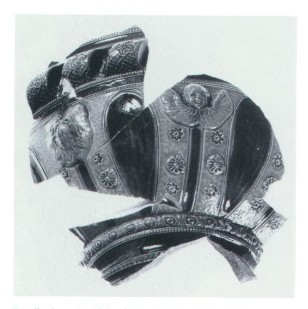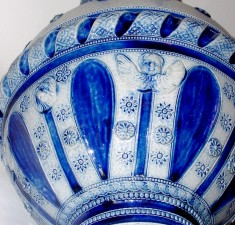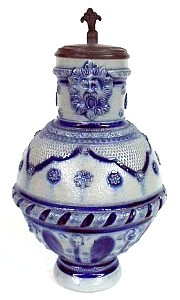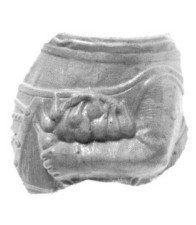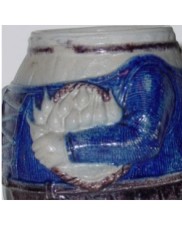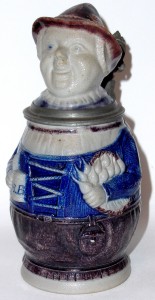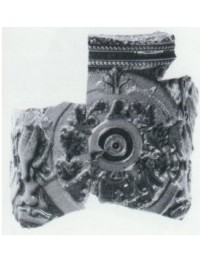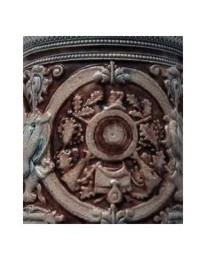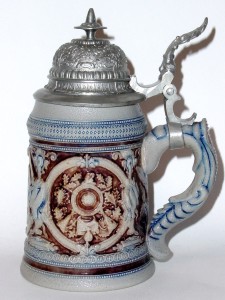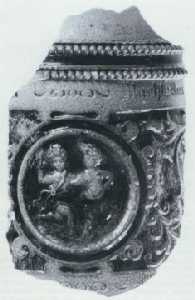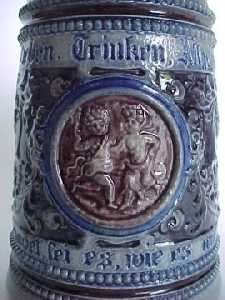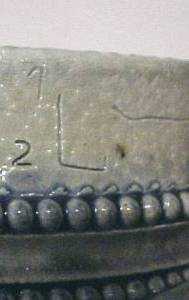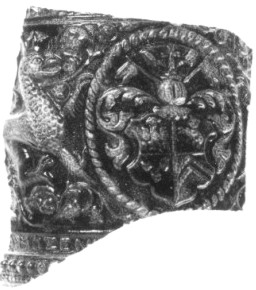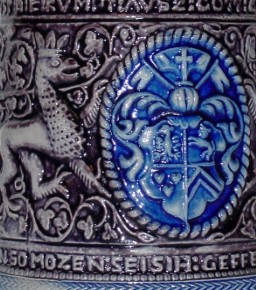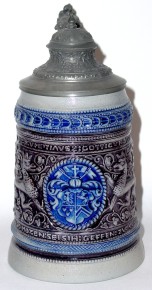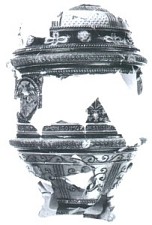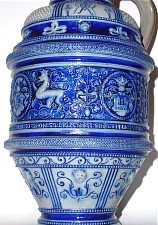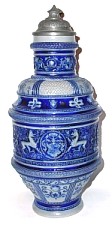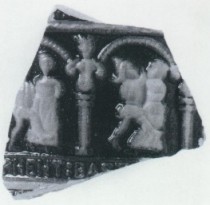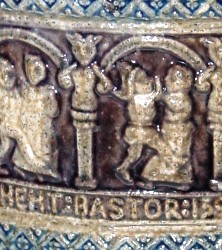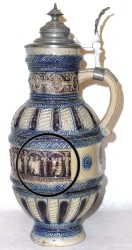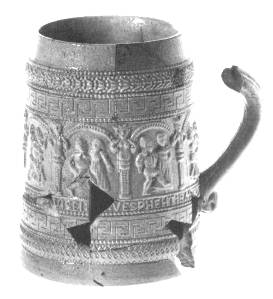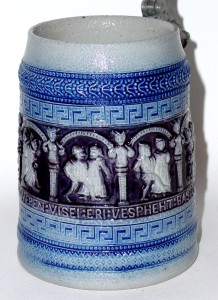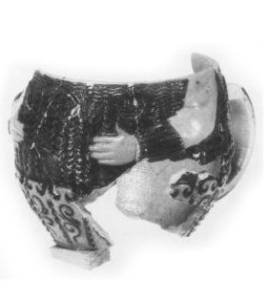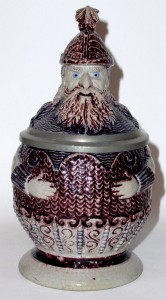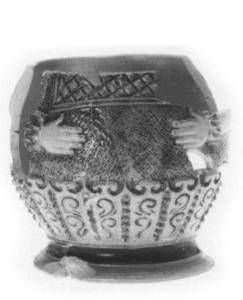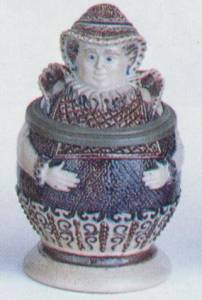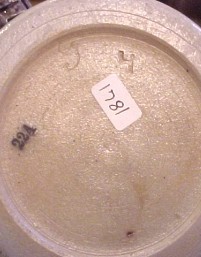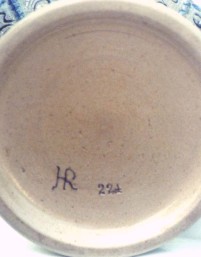|
ESTABLISHING THE CONNECTION
~~~~~~~ There have been two "digs" in Freising, of dumps (waster-heaps) specifically associated with the stoneware factory established there in 1876; one in 1988, and the other in 1990. Shards recovered from those excavated dumps provided material for two articles in Amperland magazine, a magazine dedicated to archeological discoveries in the Freising, Dachau, and Fürstenfeldbruck area. And, in a book by Herbert Hagn titled "Potters of Old Bavaria, Ceramic Finds, from the 15th Through the 19th Centuries," the last chapter is dedicated to the Freising factory and its products. This book provides additional material to that in the magazines and all three provide examples of shards from the two digs. It is generally accepted that there is a 99% plus probability that shards recovered from wasting-heaps located on property where there was a kiln in operation are products of that kiln. The 1988 dig produced shards of "altdeutche" (old German) style stoneware along with more contemporary pieces. While some of these shards appeared to have HR attributes, none of them carried the HR logo, all were stoneware, and all appeared to be unique to Freising in that they could not be attributed to any other known factory. In the 1990 dig they found a number of shards with the HR logo and pieces in stoneware, ivory stoneware, and porcelain that were recognizable as HR pieces. Some were similar in appearance to known Westerwald products. If I could match a shard from the 1988 dig to a known stein and find a characteristic, or characteristics, that carried through to steins marked HR, then I could probably feel safe in assuming that HR actually manufactured steins in Freising. When I say the steins were manufactured in Freising I mean the clay was prepared, pressed into the molds, removed from the molds, dried, cleaned, decorated, and finally, fired in the Freising factory. Manufactured means manufactured, not decorated and lidded using blanks purchased from another factory. This is not to say however that that did not occur later on. As luck would have it several of the illustrated shards matched steins I was familiar with. Without those shards to connect the steins to Freising the steins might as well have been from the Moon. I give you several examples.
Model NMN Large 3.0 liter jug. Historismus piece in Raeren style. The shard on the left was recovered from the waster-heap during the 1988 dig.
Model 57 The Alpine Lady, or Kellerein, is from the 1876-1878 Schön-Hauber period and is one of several early character steins for which shards were uncovered in 1988. This piece has a decorator initial.
Model 118 - The shard on the left is from the dump excavated in 1988 that produced material apparently unique to Freising. It is from a shooting stein just like the one on the right, which is a product of the 1876-1878, Schön-Hauber period. It has both a decorator initial and a QC mark along with a hand inscribed model number. ~~~~~~~
Model 128 - This is the first stein I was able to tie to the Freising factory. The shard on the left is also from the 1988 dig.The pictures in the middle and on the right are of a stein produced in Freising and identifiable as such thanks to this shard. The marks on this stein proved to be the linkage to HR that I needed. Note the large, "type 2" capacity mark. This large capacity mark, in its six variations, was used from 1876 through 1886. This piece also has a "Q.C." mark but no "Decorator's" initial. These marks are described in the section titled, "THE FREISING MARKS." ~~~~~~~
Model 199 - The model 199 is the first of three steins shown here that have been found so far, with and without, the HR logo. ~~~~~~~
Model NMN (199) - The model 199 Master is found in two varieties. This is the older variety in a style that is more historismus than contemporary (1876). The shards are again from the 1988 waster-heap. ~~~~~~~
Model 208 - The stoneware shard on the left is from the same Freising dump as the previous piece and is a small section of a blue and grey jug. The picture in the center shows the same section from the jug on the right, a Freising model number 208 that has both QC and Decorator marks. ~~~~~~~
Model 208 - The stein on the left has been reassembled from pieces uncovered in the 1990 Freising dig. It is marked with the "type 1a," incised HR logo and is 0.3 liter in capacity. The stein on the right is also 0.3 liter in capacity. A close examination of design elements will convince you they were manufactured in the same factory. The stein on the right is a model number 208. It was the practice in Freising to number steins of the same pattern that could be used in a set (a pouring stein and six drinking steins of any size, 3/10L, 4/10L or 1/2L) with the same model number. The 0.3 liter stein on the right, is a model 208 and logically, so is the stein on the left. The stein on the right was manufactured in Freising during the Hauber period, 1878-1882, and is not marked HR, but it has a decorator's initial. NOTE: There are 1/4 liter HR steins, but they are all in ivory stoneware, made by Merkelbach & Wick. The Freising factory itself, only produced 0.3, 0.4, 1/2 liter and larger, never a 1/4 liter. ~~~~~~~
Model 223 - The shard on the left was uncovered in the 1988 Freising dig. The lower portion of this shard and the shard below are identical and therefore could be confused with one another. The shirt and the cuffs however, identify it as the knight seen on the right. So far no knights have been reported with an HR logo. It is part of a set and there is a 3.0 liter master. It has the small font model number, the Freising "type 2" capacity mark, and the requsite Q.C. and decorator's marks. ~~~~~~~
Model 224 - The shard on the left was also uncovered in the 1988 dig. The stein is that of a lady, and again the shard is identifiable by the blouse and the cuffs. This piece is also part of a set and there is a 3.0 liter master. This piece is found marked with, and without, the HR logo. When found without the HR logo it has the "type 2," Freising capacity mark. When the HR logo is present it has the "type 3," HR capacity mark and in both cases all the requisite Q.C. and decorator's marks. This piece surfaced for the first time with the "HR" logo in Gary Kirsners, January, 1993 auction. ~~~~~~~
Those are a few of the pieces that tie HR production to the Freising factory and there are some logical observations that point to the fact that the Freising factory was the manufacturing source of these products and not just a place where they were sent to be decorated. In the March, 1992 PROSIT, Jack Lowenstein noted that a number of the recovered shards were from porcelain steins that were damaged during the firing process. He pointed out that these damaged steins wouldn't have been shipped to Freising to be decorated, and therefore must have originated in Freising. Since this was written, I have come into the posession of two HR porcelain steins that are marked with an incised, large type, Freising capacity mark, and have had three others reported to me. These marks confirm that HR porcelain steins were manufactured in Freising. Using a similar line of reasoning we note that saltglaze stoneware is decorated in a green, or semi-green, state while it is still fragile. After it is decorated it is given a firing of 6-8 days and at the height of the firing process salt is introduced into the kiln causing the saltglaze to form. The "greenware" wouldn't have been shipped to Freising to be decorated and then returned to its source for final firing and saltglazing. The entire manufacturing process, from beginning to end, would have had to occur in one location and that location was Freising. Based on the above, I believe that the Freising factory was the source of all HR marked porcelain and blue and grey stoneware with the exception of the few pieces of stoneware made by Gerz, MWG and Thewalt. The following section, "THE FREISING MARKS," should help to solidify this position. |

